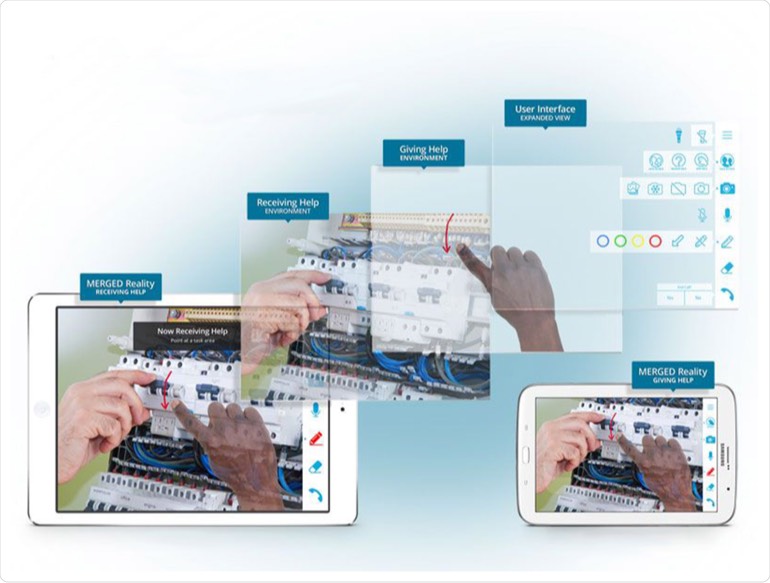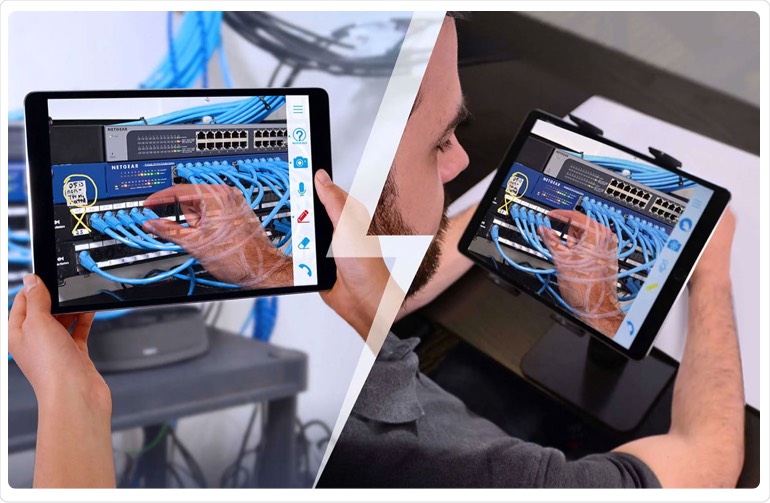
About Merged Reality
Merged reality is taking the world of field service by storm. Merged Reality combines real and virtual worlds to allow physical and digital to co-exist and interact in real-time.
Merged reality gets round a lot of the challenges of virtual reality (requiring headsets, hardware, and 3D modelling) and augmented reality (at times limited in its business application).
The technology doesn’t need special hardware or headsets, making use of patented technology to allow your remote experts to virtually reach out and touch what their service technician or customer is working on, all in real-time.
Done right, merged reality can allow service organisations to fix customer problems remotely, by being able to see the problem their customer or field service technician is having, and virtually reaching out and touching the problem, as though they are standing right next to them.

Use Cases
There are so many amazing use cases for Merged Reality, for example:
Giving help to a customer
To give help to a customer you simply initiate a Merged Reality call (via your website or a dedicated app) and place your hand, tools or other relevant objects behind your device. You’ll see your hand appear on top of your customer’s image. You can then move, freeze images, use hand gestures, pictures and even add real objects into the video scene to give dynamic help in real-time.
Receiving help from an expert
When you’re working in the field there are times when you need to receive help from an expert back at base. When you select Receive Help position your iPhone, iPad or Android device over something you’re working on. When your technical support team reaches behind their device, you’ll instantly see the other person’s hand, tools or relevant objects necessary to help, appear merged with your normal image view. This makes it easy to solve problems in the field and cost effective to do so as well!
Supporting a trainee
A trainee engineer arrives at site to take a look at an electrical fault. Using Merged Reality they are able to get support from an offsite expert who shows the trainee which component to fix; how to take a measurement and how to read and amend a number of power dials. The trainee leaves the job with confidence having completed the work right first time.
Engineers helping each other
An engineer is conducting maintenance at site and needs support from a remote expert to understand which components to read and which readings to take. Using Merged Reality they can be guided in real-time through the maintenance activity with the expert reaching in to signpost and annotate the equipment.
Giving cost-effective service
Merged reality technology can be delivered from the mobile device using real-time video calls. This ability to be “hands-on” from a remote location accelerates and simplifies the way knowledge is exchanged and problems are solved. Merged reality adds missing visual cues, gestures, and non-verbal communication methods to any session. It can allow the hand of the expert gibing help to appear on top of a colleague’s image. Telestrating, freezing images, using hand gestures and even adding real objects into the scene can get the point across in an easy and intuitive manner.
Research indicates that nonverbal cues are 430% more effective than verbal cues and that nonverbal cues make verbal/nonverbal communication combinations up to 10 times more effective. Instant, accurate communication augmented by mobile merged reality and virtual presence can have a dramatic impact on service operations and proactively, efficiently and effectively attack hard costs that plague the efficiency and effectiveness of operations and customer interactions.

Rapid benefits
Our experience suggests that customers can experience a 7 to 15 times hard cost savings for every pound invested. Expert personnel can see a 10 to 20% efficiency increase. In addition an estimated 33% of service work orders require a second trip. Using merged reality you can help eliminate 18% of second trips that are required due to a lack of experience. Merged reality will also reduce 19% of second trips caused by limited access to information, and avoid 28% of second trips caused by wrong diagnoses.
There are many customer success stories from merged reality. For example a large field service team that were able to fix a problem remotely leading to saving of £6,000 in parts and labor. A manufacturing company in the UK was able to reduce field service costs by £11,500 in the first month of using merged reality. A service organisation was able to save between 5-10 truck rolls per week (at an average cost of £90 per truck roll), leading to monthly savings of up to £3,700 per month.